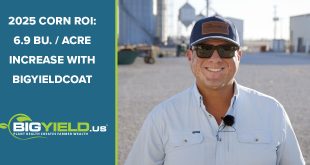In-crop burning can serve as a chemical-free alternative for controlling weeds and insects in your fields as crops emerge and establish themselves. Before you head into a field with an in-crop, in-row burner, however, you should know several critical tips. Here are the top five things to know about in-crop burning from Kent Kauffman of our BigYield.us team.
1. Position the burner’s torch heads to the correct height, and ensure that they stay lit. We at BigYield.us recommend that growers test a burner before entering a field. The test can highlight any positioning and lighting problems.
2. Focus on wilting, not crisping, weeds that you’re trying to control. A weed that properly wilts will die within two days to three days. To test whether a burner has adequately wilted a weed, press your finger on the weed after exposing it to heat. If you can see your fingerprint, then the weed has wilted properly. Attempting to crisp a weed may lead to creating too much heat in a field, and it may damage the crop itself.
3. Find the growth point on the crop, and avoid targeting it with the torch. The flame from a burner should avoid reaching a crop’s growth point. If the growth point is below the soil surface, then a burner can safely pass over the top of the ground without causing damage to the crop. If the growth point has emerged from the soil, then the burner’s flame should be directed to a point below the crop’s growth point.
4. Time your burner pass appropriately. Smaller weeds are easier to control than larger weeds. As a result, monitor weed size on a regular basis. Your burner equipment should be ready for use as weather allows and before the weeds grow too tall.
5. Formulate a fire safety plan. Running a burner means that you’re exposing the environment to open flames. Keep a fire extinguisher with you in case a flame doesn’t quickly extinguish on its own, and watch that the flame doesn’t spread past the field to other nearby areas.
To learn more about controlling weeds and insects with an in-crop burner, call our BigYield.us team at 844-242-4367, or go to http://bigyield.us/.
Video Transcription
Hi everybody. This is Kent Kauffman, coming to you from the research farm in Garden City with BigYield.us Today we’re going to talk about the five critical things to know with in-crop / in-row burning.
The first thing to know is to know that you’re torch heads are positioned correctly and stay lit. It’s good to always test out your burner before you use it. Drive around a little bit, make sure all the torch heads stay lit. Some manufacturers have had some issues with that. We specifically make our burners designed so that they won’t blow out the pilot light, but some have seen that problem. Make sure they stay lit and make sure they relight each other when they are going, and make sure they are positioned at the correct height before you go out into your field.
The second thing to know is that you do not need to crisp the weeds, you just have to wilt them. You can do the fingerprint test – go through your crops with the burner, and you should be able to put your finger on a leaf. If you see your fingerprint on a weed, it is going to die in two to three days. You don’t have to burn it to a crisp, so you can go a little bit faster because when you go that slow you can cause damage to your crops.
The number three issue to know is to know where the growth point is on the crop that you are burning. That is what you want to avoid – getting that heat, that thermal weed control, on your crop. You need to make sure it’s underneath the ground. With corn, it’s usually around the fifth to sixth leaf that attaches to the stem. If that is below the ground, you can burn over top. If that is above the ground, you want that growth point to be above your flame. Same thing with soybeans. You want that growth point to be above the flame so you don’t kill your plant and you do kill your weeds.
That leads us into our fourth point which is timing is critical. So, you really kill weeds best when they are small – same as you would with chemicals. The smaller the weed is, the easier it is to kill. You have to be able to get out into your fields quickly, and you have to be able to cover all of your fields when you have an opening in the weather. Have your propane in your tank, have everything set up so if the rain breaks and you have a weed problem, you can go out there right away and take care of it.
Finally, the fifth point is always have a plan for if things don’t go right. You are working with very high temperature flames and a lot of things could go wrong. We’ve designed in a lot of safety features, but if they do go wrong, have a fire extinguisher and know what is around you to burn. If you can, do ring rows just to singe that grass and those weeds around your fields so nothing spreads out. Just pay attention and be careful out there.
This is Kent Kauffman, BigYield.us. Check us out.
 BigYield High Yield Soybeans, High Yield Corn, and High Yield Wheat
BigYield High Yield Soybeans, High Yield Corn, and High Yield Wheat



